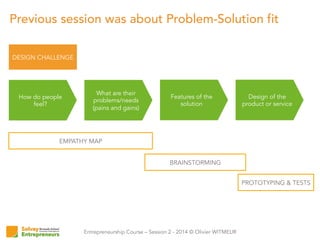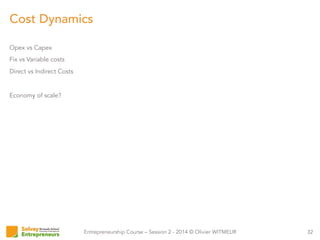HOW TO DESIGN MY BUSINESS MODEL? - SESSION 4
- 1. www.solvayentrepreneurs.be HOW TO DESIGN MY BUSINESS MODEL? SESSION 4 (out of 10) BUSINESS MODEL GENERATION This session is part of a 10-weeks course given to master students of the SOLVAY BRUSSELS SCHOOL OF ECONOMICS AND MANAGEMENT by professor Olivier WITMEUR.
- 2. Entrepreneurship Course – Session 2 - 2014 © Olivier WITMEUR 2 • How to capture value? • How to generate value? QUESTIONS AGENDA RESOURCES • Back to the previous session • Introduction to Business Model Generation + Exercises • Your road to the final assignment (intro) • The business model canvas Desired Outcomes of the Session
- 3. Entrepreneurship Course – Session 2 - 2014 © Olivier WITMEUR BACK TO THE DESIGN THINKING SESSION #1
- 4. Entrepreneurship Course – Session 2 - 2014 © Olivier WITMEUR Previous session was about Problem-Solution fit How do people feel? What are their problems/needs (pains and gains) Features of the solution Design of the product or service DESIGN CHALLENGE EMPATHY MAP BRAINSTORMING PROTOTYPING & TESTS
- 5. Entrepreneurship Course – Session 2 - 2014 © Olivier WITMEUR Another view on the design thinking process 5 * Adapted from Tim Brown
- 6. Entrepreneurship Course – Session 2 - 2014 © Olivier WITMEUR An alternative to empathy map: AEIOU Framework Activities – What are people doing? Environment – How are people using the environment – What is the role of the environment Interactions – Do you see any routines? – Do you observe special interactions between people? Between people & objects? Objects – What’s there and being used or not used? – Describe engagement with objects Users – Who are the users? What are their roles? – Look for extreme users 6 Source: Doblin, Inc. by Rick Robinson and Stef Norvaisis
- 7. Entrepreneurship Course – Session 2 - 2014 © Olivier WITMEUR BUSINESS MODEL GENERATION #2
- 8. Entrepreneurship Course – Session 2 - 2014 © Olivier WITMEUR One bestseller… 8
- 9. Entrepreneurship Course – Session 2 - 2014 © Olivier WITMEUR Definition A business model is a conceptual tool that contains a set of elements and their relationships and allows expressing a company's logic of earning money. It is a description of – the value a company offers – to one or several segments of customers and – the architecture of the firm and its network of partners for creating, marketing and delivering this value and relationship capital, – in order to generate profitable and sustainable revenue streams. 9
- 10. Entrepreneurship Course – Session 2 - 2014 © Olivier WITMEUR 10 4 MAIN QUESTIONS
- 11. Entrepreneurship Course – Session 2 - 2014 © Olivier WITMEUR 4 Main questions = 4 Areas of the framework 11 How? How much? Who?What? The bundle of products & services that create value The different groups of people or organizations an enterprise aims to reach and serve, + the tactic to reach them & to develop relationships with them The configuration of resources, competences, activities and partnerships to create & deliver the value The cash a company generates from each Customer Segment All costs incurred to operate a business model
- 12. Entrepreneurship Course – Session 2 - 2014 © Olivier WITMEUR 12 9 BUILDING BLOCKS
- 13. Entrepreneurship Course – Session 2 - 2014 © Olivier WITMEUR Customer segments 13
- 14. Entrepreneurship Course – Session 2 - 2014 © Olivier WITMEUR Defining a Segment, often a Niche Type of segments • Mass Market • Niche Market • Segmented • Diversified • Multi-sided platform • … 14
- 15. Entrepreneurship Course – Session 2 - 2014 © Olivier WITMEUR Value Proposition 15
- 16. Entrepreneurship Course – Session 2 - 2014 © Olivier WITMEUR Value Proposition VP creates value for a Customer Segment through a distinct mix of elements catering to that segment’s needs. Values may be quantitative or qualitative Examples: – Newness ... ? – Performance … ? – Customization … ? – Design, Brand / Status … ? – Price, Cost Reduction … – Risk Reduction … ? – Accessibility, Convenience, stability … ? 16
- 17. Entrepreneurship Course – Session 2 - 2014 © Olivier WITMEUR Typical Value Propositions / Positionning 17 * Treacy & Wiesema (1994) The Discipline of Market leaders
- 18. Entrepreneurship Course – Session 2 - 2014 © Olivier WITMEUR Channels 18
- 19. Entrepreneurship Course – Session 2 - 2014 © Olivier WITMEUR Channels • Own vs Partners • Direct vs Indirect Examples – Sales team – Point of Sales, Shops… – Two-tier retail – Integrators, VAR’s (Value Added Resselers) – Websites: dedicated or extisting market places – OEM (Original Equipment Manufacturers) – Franchise 19
- 20. Entrepreneurship Course – Session 2 - 2014 © Olivier WITMEUR Customers Relationship 20
- 21. Entrepreneurship Course – Session 2 - 2014 © Olivier WITMEUR Customers Relationship • Personal assistance; human interaction, real customer representative, on- site at the point of sale, call centers, e-mail, … • Dedicated personal assistance: dedicating a customer representative specifically to an individual client. • Self-service: no direct relationship with customers. It provides all the necessary means for customers to help themselves. • Automated services: customer self-service with automated processes. • Communities: Increasingly, companies are utilizing user communities to become more involved with customers/prospects and to facilitate connections between community members. • Co-creation: More companies are going beyond the traditional customer-vendor relationship to co- create value with customers. 21
- 22. Entrepreneurship Course – Session 2 - 2014 © Olivier WITMEUR Get, Keep, Grow framework 22 Channels + Customer Relations = Get-Keep-Grow (see sessions on start and growth strategies)
- 23. Entrepreneurship Course – Session 2 - 2014 © Olivier WITMEUR Revenues Mix 23
- 24. Entrepreneurship Course – Session 2 - 2014 © Olivier WITMEUR Mixing Revenues • Product sales • Usage fees (e.g. Saas) • Service fees • Long term subscription / Renting • Flat vs variable prices 24
- 25. Entrepreneurship Course – Session 2 - 2014 © Olivier WITMEUR Key Activities 25
- 26. Entrepreneurship Course – Session 2 - 2014 © Olivier WITMEUR Linking Value Proposition and Core Activities 26 * Treacy & Wiesema (1994) The Discipline of Market leaders
- 27. Entrepreneurship Course – Session 2 - 2014 © Olivier WITMEUR Key Resources 27
- 28. Entrepreneurship Course – Session 2 - 2014 © Olivier WITMEUR VRIN Resources Valuable (value generating) Rare Inimitable (isolating mechanism) Non substituable (no subtitutes) Example – Know How, Patent… – Brand – Location – Agreement 28
- 29. Entrepreneurship Course – Session 2 - 2014 © Olivier WITMEUR Key Partners 29
- 30. Entrepreneurship Course – Session 2 - 2014 © Olivier WITMEUR Typical partners Specialized suppliers Technology / IP owner Franchiser Financial partners Key people … (can be a customer, a channel …) 30
- 31. Entrepreneurship Course – Session 2 - 2014 © Olivier WITMEUR Cost structure 31
- 32. Entrepreneurship Course – Session 2 - 2014 © Olivier WITMEUR Cost Dynamics Opex vs Capex Fix vs Variable costs Direct vs Indirect Costs Economy of scale? 32
- 33. Entrepreneurship Course – Session 2 - 2014 © Olivier WITMEUR 9 blocks to represent a business model 33 * A. Osterwalder & Y. Pigneur, 2010
- 34. Entrepreneurship Course – Session 2 - 2014 © Olivier WITMEUR ‘The’ official Business Model Generation Canvas 34
- 35. Entrepreneurship Course – Session 2 - 2014 © Olivier WITMEUR Back to the strategy course! 35 Value Chain theory Blue Ocean Strategy Strategic and marketing segmentation Resources-based view Strategic Alliances Sourcing
- 36. Entrepreneurship Course – Session 2 - 2014 © Olivier WITMEUR Typical (difficult) questions Transactional vs Recurring revenues Product vs Service Niche vs Mass market Capex vs Partnerships Pick the right customer segment Open vs Closed Personal vs Automated Physical vs Virtual Direct vs Indirect sales Fixed vs Variable costs Tailor-made vs Mass production … 36
- 37. Entrepreneurship Course – Session 2 - 2014 © Olivier WITMEUR Different ways to start new venture 37 Starting from one idea … but looking for a problem to solve Starting from the customer You know his/her problem Starting from a unique resource IP, Know-how, location… Knowing of to optimize P&L
- 38. Entrepreneurship Course – Session 2 - 2014 © Olivier WITMEUR DESIGN your business Model Generate multiple options and test scenario. 38
- 39. Entrepreneurship Course – Session 2 - 2014 © Olivier WITMEUR Make it also as creative as possible. • Use brainstorming method • What if … – No internet – Only mobile – No frontiers – … • Post it are very flexible • Drawing > Writing • Diverge – Converge logic 39
- 40. Entrepreneurship Course – Session 2 - 2014 © Olivier WITMEUR Example: Apple iPod/iTunes Business Model Nespresso Business Model 40
- 41. Entrepreneurship Course – Session 2 - 2014 © Olivier WITMEUR Additional comments There are multiple other templates for designing business models / strategy. The BMG tool has limitations, incl. – Block definition is debatable. • You sometimes have to merge or spilt some of them à Feel free to adapt – Nothing about the environment – Very little about the organization of the company – Static tool? Use colors to explain development stages 41
- 42. Entrepreneurship Course – Session 2 - 2014 © Olivier WITMEUR YOUR ROAD TO THE NEXT ASSIGNMENT #2 42
- 43. Entrepreneurship Course – Session 2 - 2014 © Olivier WITMEUR The main steps towards your final project. 43 VALUE PROPOSITION BUSINESS MODEL ROADMAP Key activities, resources & partners Revenues model & costs structure Problem-Solution fit Product-Market fit Market sizing Competition Stages & milestones Get-Keep-Grow Risks & scenario FINANCE P&L, cash and balance sheet Financing CREATE TEST LEARN YOU
- 44. Entrepreneurship Course – Session 2 - 2014 © Olivier WITMEUR 44 NEVER STOP WONDERING & ASKING!
- 45. Entrepreneurship Course – Session 2 - 2014 © Olivier WITMEUR A real passion for entrepreneurship education and entrepreneurs. • Student entrepreneurs: 2x • Full time entrepreneur: once, in a team of 5 • Coach: 500+ projects over the last 20 years • (Advisory) Board member in multiple new ventures • Policy making: 2x • Director of Solvay Entrepreneurs • PhD in entrepreneurship in 2008 • … never as an investor My wife (as Colombo), no kids, one dog (Vicky). 45 Olivier Witmeur (Belgian, 46)
- 46. Entrepreneurship Course – Session 2 - 2014 © Olivier WITMEUR Solvay entrepreneurs is the entrepreneurship center of the Université Libre de Bruxelles. We support entrepreneurs through the development of their venture, from an idea to a successful and sustainable business. 46 Solvay Entrepreneurs
- 47. Entrepreneurship Course – Session 2 - 2014 © Olivier WITMEUR Let’s keep in touch! 472014%©%Olivier%Witmeur FOLLOW US ON LinkedIn.com/company/ Solvay-Entrepreneurs in Facebook.com/ SolvayEntrepreneurs f Twitter.com/ SolvayStart t SolvayEntrepreneurs.be www YouTube.com/user/ SolvayEntrepreneurs Foursquare.com/ SolvayStart















































